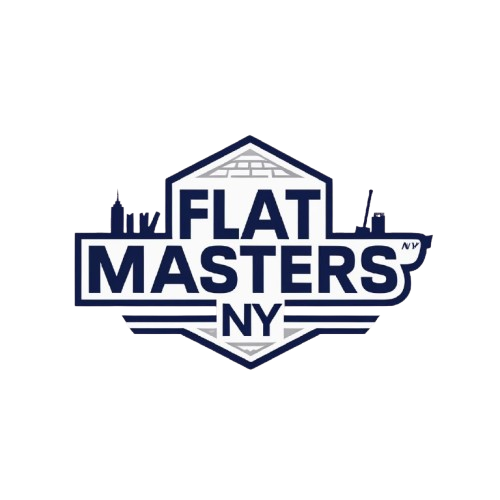Professional Roll Roofing on Flat Roof Installation & Repair
Roll roofing on flat roofs is one of those solutions that gets a bad rap until you understand when and how to use it properly. After installing flat roofs across Queens for over two decades, I've seen roll roofing save the day on countless projects - and I've also seen it fail miserably when applied incorrectly.
The truth is, roll roofing application on flat surfaces requires specific techniques that differ dramatically from pitched roof installations. You can't just roll it out like carpet and hope for the best.
When Roll Roofing Makes Sense for Flat Roofs
Let me be straight with you - roll roofing isn't always the answer for flat roofs, but it has its place. In my experience working on everything from Astoria apartment buildings to Flushing warehouse spaces, roll roofing works best as a temporary solution or on low-traffic flat surfaces where budget is a primary concern.
The material itself is essentially asphalt-saturated felt with mineral granules on the surface. It comes in 36-foot rolls, typically 36 inches wide, and costs significantly less than modified bitumen or EPDM rubber roofing systems.
Here's where I see it working well: utility sheds, small garage roofs, covered patios, and temporary structures. The key word here is temporary - even the best roll roofing installation rarely lasts more than 10-12 years on a flat surface.
The Reality of Roll Roofing Costs in Queens
| Roof Size | Material Cost | Labor Cost | Total Range |
|---|---|---|---|
| Small Shed (8x10) | $120-180 | $300-450 | $420-630 |
| Garage (12x20) | $280-350 | $600-900 | $880-1,250 |
| Small Commercial (20x30) | $650-850 | $1,200-1,800 | $1,850-2,650 |
| Large Flat Roof (30x50) | $1,200-1,600 | $2,500-3,500 | $3,700-5,100 |
These numbers reflect what we're seeing in Queens right now, but don't let the low cost fool you into thinking this is always the smart choice.
How to Roll Roof a Flat Roof - The Professional Method
This is where things get technical, and frankly, where most DIY attempts go sideways. How to roll roof a flat roof properly involves several critical steps that can't be skipped or rushed.
First, the deck preparation is everything. The surface needs to be completely clean, dry, and smooth. Any debris, loose nails, or uneven areas will telegraph through the roll roofing and create failure points. On flat roofs, water doesn't shed like it does on sloped surfaces, so every imperfection becomes a potential leak.
The installation starts with a starter strip along the lowest edge of the roof. This strip should overlap the roof edge by about half an inch, and it needs to be perfectly straight - any waviness here will be magnified as you work your way up the roof.
Here's something most people don't realize: roll roofing on flat surfaces requires different adhesive patterns than what you'd use on a sloped roof. We use a full-spread adhesive application rather than the spot-application you might use on a pitched surface. This creates a complete seal that prevents wind uplift and water infiltration.
The Overlap System That Actually Works
Roll roofing overlaps are critical, and they're different for flat roofs than pitched ones. We use a 6-inch overlap on the sides and a 4-inch overlap on the ends, but here's the key - that overlap needs to be sealed with roofing cement, not just laid down and nailed.
The nailing pattern matters too. On flat roofs, nails go every 6 inches along the edges and 12 inches in the field, but they need to be placed in the overlap area, not in the exposed roofing material. Every nail that penetrates the exposed surface is a potential leak point.
Temperature matters more than you think. Roll roofing becomes brittle in cold weather and too soft in extreme heat. The sweet spot for installation is between 45°F and 85°F. I've seen guys try to install roll roofing on a 95-degree day in August, and it's a disaster - the material stretches and tears as they work with it.
Why Most Roll Roofing Fails on Flat Surfaces
Let's talk about why roll roofing gets such a bad reputation on flat roofs, because understanding the failure modes helps you avoid them.
The biggest issue is inadequate slope. Even "flat" roofs need some drainage - typically a quarter-inch per foot minimum. Roll roofing on a truly flat surface will pool water, and standing water will eventually find its way through any seam or nail penetration.
The second major failure point is thermal movement. Flat roofs experience much greater temperature swings than sloped surfaces because they're fully exposed to sun and sky. Roll roofing expands and contracts with these temperature changes, and if it's not properly detailed at the edges and penetrations, it will crack or pull apart.
Edge details kill more roll roofing installations than anything else. You can't just run the material to the edge and call it good. Proper edge flashing, drip edges, and fascia details are essential, and they're often the first things to fail when corners are cut.
Better Alternatives to Consider
Look, I'll install roll roofing when it makes sense, but I always present alternatives. Modified bitumen systems cost about 40% more but last twice as long. EPDM rubber roofing costs about double but can last 20+ years with proper maintenance.
For most flat roof situations in Queens, I'm pushing clients toward modified bitumen systems. The installation process is similar to roll roofing, but the material is much more durable and the seaming methods are more reliable.
If budget is absolutely critical, at least consider upgrading to a heavier-weight roll roofing - 90-pound instead of the standard 55-pound material. The cost difference is minimal, but the durability improvement is significant.
Maintenance and Expectations
Here's what nobody tells you about roll roofing on flat roofs - it needs attention. Annual inspections are essential, and small repairs need to happen immediately. A $20 tube of roofing cement applied to a small crack can prevent a $2,000 leak repair.
The granule loss starts almost immediately on flat surfaces because there's no slope to shed debris. This isn't necessarily a failure, but it does mean the underlying felt is more exposed to UV radiation.
Expect to do some maintenance every 2-3 years - typically resealing seams and dealing with minor edge lifting. Plan for replacement in 8-12 years depending on weather exposure and maintenance quality.
When to Call a Professional
Honestly? Most of the time. Roll roofing application looks simple, but the details matter enormously on flat surfaces, and getting them wrong means starting over in a few years instead of getting the full service life from the material.
The tools alone make it worth hiring a pro - proper adhesive spreaders, seaming rollers, and cutting tools make a huge difference in the final result. Plus, any reputable contractor will warranty the installation, which gives you recourse if problems develop.
At Flat Masters NY, we see too many DIY roll roofing jobs that fail within the first two years because critical details were missed. The material cost savings disappear quickly when you factor in the cost of doing it twice.
The bottom line: roll roofing can work on flat roofs, but it requires proper installation and realistic expectations. It's not a permanent solution, but it can be an effective temporary or budget fix when applied correctly. Just don't expect miracles from a budget material, and don't skip the important details that make the difference between success and failure.

